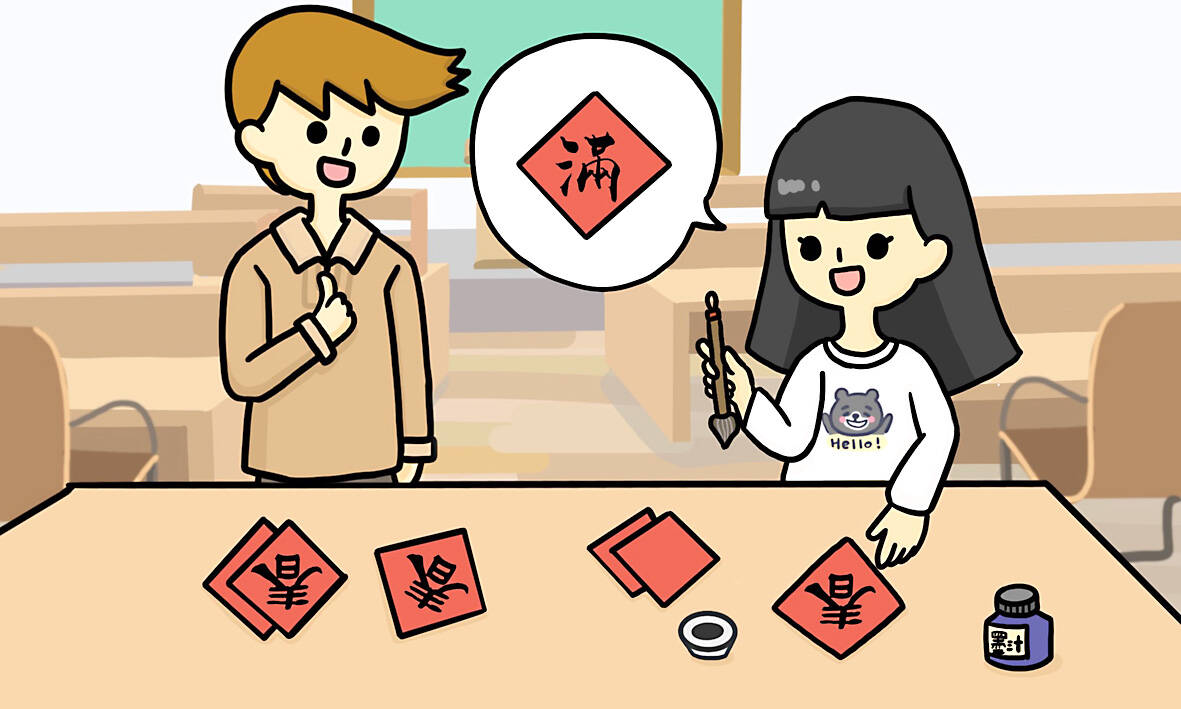對話 Dialogue
馬克:小實,你用毛筆在寫什麼啊?
Mǎkè: Xiǎoshí, nǐ yòng máobǐ zài xiě shénme a?

小實:我在寫「春」字啊!
Xiǎoshí: Wǒ zài xiě chūn zì a!
馬克:看起來很有趣耶,你在準備農曆新年嗎?
Mǎkè: Kàn qǐlái hěn yǒuqù yé, nǐ zài zhǔnbèi nónglì xīnnián ma?
小實:對啊,這是我要貼在家裡祈求好運的。
Xiǎoshí: Duì a, zhè shì wǒ yào tiē zài jiālǐ qíqiú hǎoyùn de.
馬克:你用紅紙代表喜慶,「春」字是代表春天要來了嗎?
Mǎkè: Nǐ yòng hóngzhǐ dàibiǎo xǐqìng,`chūn' zì shì dàibiǎo chūntiān yào lái le ma?
小實:沒錯,除了「春」以外,「福」也是過年常用的字喔!
Xiǎoshí: Méicuò, chúle `chūn' yǐwài,`fú' yěshì guònián chángyòng de zì ō!
馬克:「福氣」的「福」嗎?我猜應該是希望新的一年很好運。
Mǎkè: `Fúqi' de `fú' ma? Wǒ cāi yīnggāi shì xīwàng xīn de yì nián hěn hǎoyùn.
小實:沒錯!還有「滿」字也常貼在冰箱外,祈求新年食物足夠。
Xiǎoshí: Méicuò! Hái yǒu `mǎn' zì yě cháng tiē zài bīngxiāng wài, qíqiú xīnnián shíwù zúgòu.
馬克:這實在太有趣了,我也想要學寫這些字!
Mǎkè: Zhè shízài tài yǒuqù le, wǒ yě xiǎng yào xué xiě zhèxiē zì!
翻譯 Translation
Mark: Xiaoshi, what are you writing with that Chinese brush?
Xiaoshi: I am writing the character chun [spring].
Mark: That looks interesting. Are you preparing for Lunar New Year?
Xiaomi: Yes, I will put this up at home as a prayer for good luck.
Mark: You used red paper to represent joy. Does the word chun mean that spring is coming?
Xiaomi: Yes, in addition to chun, fu [bliss] is another commonly used word during Lunar New Year.
Mark: Is “blessing” the same as fu? I guess you wish good luck in the new year.
Xiaoshi: That’s right! And the character man [full] is often stuck on the refrigerator to pray for enough food in the New Year.
Mark: This is so interesting. I want to learn to write these words, too!
單字片語 Vocabulary
1. 農曆 (Nónglì) lunar calendar
2. 祈求 (qíqiú) to pray
3. 好運 (hǎoyùn) good luck
4. 代表 (dàibiǎo) to represent
5. 喜慶 (xǐqìng) joy, festive
6. 福氣 (fúqi) blessing
7. 足夠 (zúgòu) enough
8. 實在 (shízài) really
教材音檔 Audio Files
教材影片 Video Files:
https://www.instagram.com/celc.nou_tw/guide/_/17999106352646292/
實踐大學華語中心提供
By Shih Chien University Chinese Language Center: https://chineseusc.com/

A: When is the Lantern Festival? B: The festival is celebrated on the 15th day of the first month of the lunar calendar, which fell on Feb. 12 this year. A: Oh no! Did I miss the 2025 Taipei Lantern Festival? B: Yes, you did. But you can still go to the 2025 Taiwan Lantern Festival in Taoyuan, which will run until this Sunday. A: Let’s go admire the exuberant lanterns. A: 元宵節到底是哪一天? B: 就是農曆1月15日啊,今年則落在國曆2月12日。 A: 喔不,我是不是錯過了2025台北燈節? B: 是的,但你還可以去桃園的2025台灣燈會,活動將持續至週日。 A: 那我們去欣賞豐富的花燈秀吧! (By Eddy Chang, Taipei Times/台北時報張聖恩)

Every February, the small town of Ptuj in Slovenia comes alive with the vibrant celebration of its famous carnival. This festival, with its deep historical roots, is a cherished tradition where local residents come together to ward off the winter cold and embrace the arrival of spring. Participants dress up in furry costumes, transforming into kurenti, mythical monsters believed to drive away evil spirits and bring good fortune for the new year. Although the exact origins of the Ptuj carnival remain a mystery, it is firmly rooted in ancient Slavic and Illyrian cultures. The modern form of the carnival

A: What’s the theme of the 2025 Taiwan Lantern Festival’s main lantern? B: The theme is “Paradise,” and the main lantern is a snake-shaped “infinity” symbol that features a lighting show every half an hour. A: Cool, I heard that there are over 300 lanterns. B: There are even giant lanterns in the shape of Pikachu and some other popular Pokemon characters. A: Let’s go now. A: 2025台灣燈會主燈的主題是什麼? B: 主題是「無限樂園」!主燈的造型則是蛇形的數學「無限號」,主燈每半小時還有一次燈光秀。 A: 酷喔,聽說總共有300多件花燈作品。 B: 甚至還有皮卡丘和其他熱門寶可夢角色的巨型花燈呢。 A: 哇我們現在就出發吧! (By Eddy Chang, Taipei Times/台北時報張聖恩)

本文由生成式AI協作,本刊編輯編修。 Tucked away in southwestern Taiwan, Yunlin County is a treasure trove of cultural heritage, rich history, and natural beauty. From its stunning temples and glove puppetry to historical architecture and picturesque landscapes, Yunlin rewards those who venture off the beaten path. Yunlin is renowned for its flourishing temple culture. Temples in this region are not merely places of worship but also communal centers where people gather for festivals, rituals, and social functions. One of the most notable temples here is the Beigang Chaotian Temple, which was built more than 300 years ago and is dedicated to Matsu, the sea